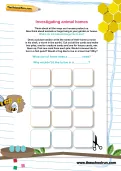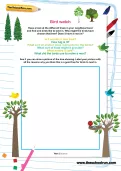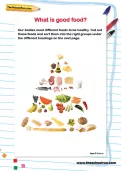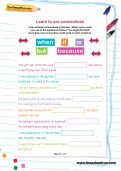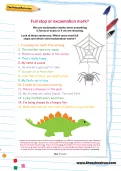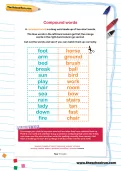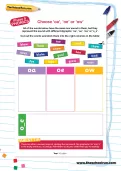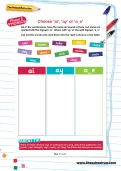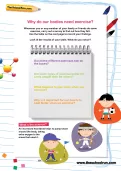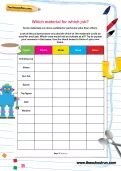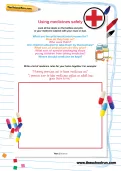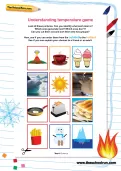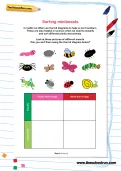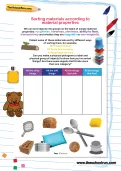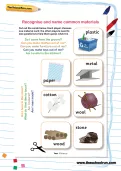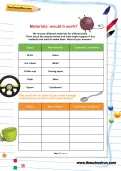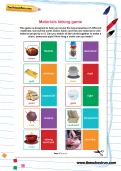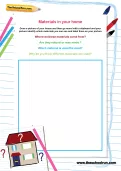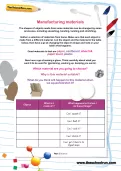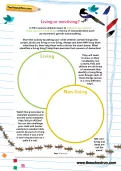Look at these connectives in this box. Which ones could you use in the sentences below? You might find that more than one connective could work in each sentence.
or
Register to add to your saved resources
Already a subscriber? to view this content.
We use exclamation marks when something is funny or scary or if we are shouting. Look at these sentences. Which ones need full stops and which need exclamation marks?
or
Register to add to your saved resources
Already a subscriber? to view this content.
A compound word is a long word made up of two short words. The blue words in the left-hand column go first; the orange words in the right-hand column go second. Cut out the words and see if you can match them up correctly.
or
Register to add to your saved resources
Already a subscriber? to view this content.
Should these sentences end in a full stop, a question mark or an exclamation mark? Choose the correct punctuation mark for each one, and don’t forget to add in capital letters if they’re missing!
or
Register to add to your saved resources
Already a subscriber? to view this content.
All these words have the /oa/ sound in them, but some are spelled with the digraph 'oa', others with 'oe' or 'ow' or 'o_e'. Can you cut out the words and stick them into the right columns in the table?
or
Register to add to your saved resources
Already a subscriber? to view this content.
All of these words have the same /ai/ sound in them, but some are spelled with the digraph 'ai', others with 'ay' or the split digraph 'a_e'. Can you cut out the words and stick them into the right columns in the table?
or
Register to add to your saved resources
Already a subscriber? to view this content.
A Year 2 printable worksheet created by a primary school teacher to help your child with capital letters and punctuation marks.
Read this paragraph and add in the capital letters, full stops, commas, exclamation marks and question marks where you think they should go
or
Register to add to your saved resources
Already a subscriber? to view this content.
Whenever you or any member of your family or friends do some exercise, carry out a survey to find out how they felt. Use the table to record your findings. Look at the results of your table. What do you notice?
or
Register to add to your saved resources
Already a subscriber? to view this content.
Some materials are more suitable for particular jobs than others. Look at these pictures and decide which of the materials could be used for each job. Which ones would not be suitable at all?
or
Register to add to your saved resources
Already a subscriber? to view this content.
Look at the labels on the bottles and pills in your medicine cabinet with your mum or dad. Can you answer these questions about them?
or
Register to add to your saved resources
Already a subscriber? to view this content.
Look at these pictures. Can you identify what each item is? Which ones generate heat? Which ones don’t? Can you cut them out and sort them into two groups?
or
Register to add to your saved resources
Already a subscriber? to view this content.
In maths we often use Carroll diagrams to help us sort numbers. These are also helpful in science when we need to classify and sort different plants and animals. Look at these pictures of different insects.
Can you sort them using the Carroll diagram?
or
Register to add to your saved resources
Already a subscriber? to view this content.
We can sort objects into groups on the basis of simple material properties: roughness, hardness, shininess, ability to float, transparency and whether they are magnetic or non-magnetic. Collect some of these materials and try different ways of sorting them. Can you make a physical pictogram to show how you’ve sorted things?
or
Register to add to your saved resources
Already a subscriber? to view this content.
Look at these pictures. Can you identify the objects? Which ones do you think will float in water? Which ones will sink? Why? Ask a parent if there any that you can test.
or
Register to add to your saved resources
Already a subscriber? to view this content.
Cut out the cards below. Each player chooses one material card; the other players need to ask questions to help them guess what it is.
or
Register to add to your saved resources
Already a subscriber? to view this content.
We choose different materials for different jobs. Think about the objects below and what might happen if this material was used to make them. Record your answers.
or
Register to add to your saved resources
Already a subscriber? to view this content.
This game is designed to help you revise the key properties of different materials. Cut out the cards below. Each card has one material or one material property on it. Can you match all the cards together to make a chain, dominoes-style? How long a chain can you make?
or
Register to add to your saved resources
Already a subscriber? to view this content.
Draw a picture of your house and then go round with a clipboard and identify which materials you can see and label them on your picture.
or
Register to add to your saved resources
Already a subscriber? to view this content.
The shapes of objects made from some materials can be changed by some processes, including squashing, bending, twisting and stretching. Gather a selection of materials from home. Make sure that each object is made from a different material. List the object and the material in the table, then have a go at changing the object’s shape and note on your table what happens.Now have a go at making a glove.
or
Register to add to your saved resources
Already a subscriber? to view this content.
In KS1 science children learn to differentiate between living and non-living things in terms of characteristics such as movement, growth and breathing. Identify which things are living and which are non-living, but watch out ... sometimes it's not as obvious as it seems!
or
Register to add to your saved resources
Already a subscriber? to view this content.
